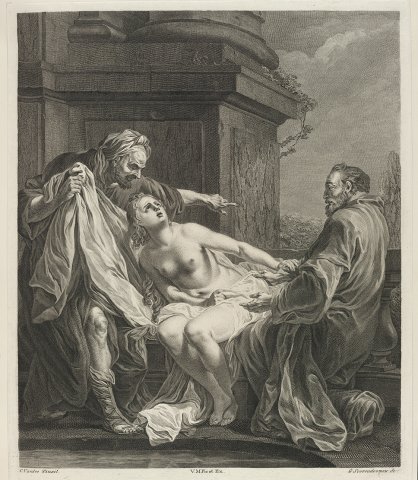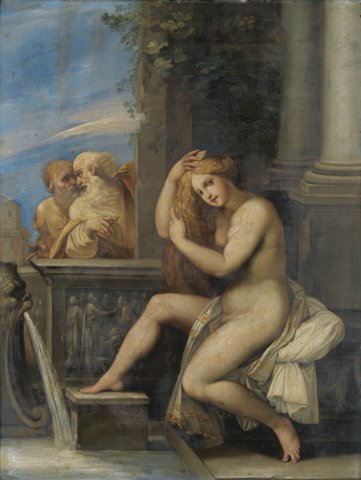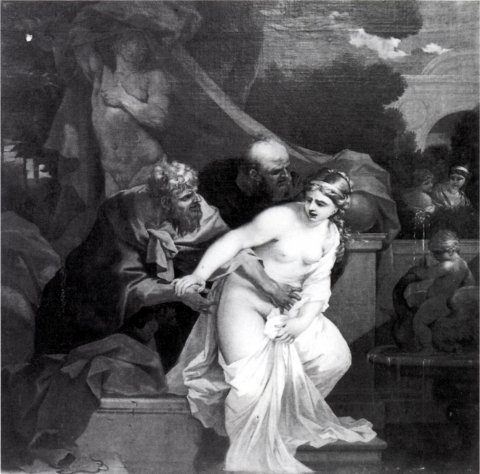[35]
3. Chaste Suzanne. (#000783)
From the same.
Table 7 feet 6 inches high, by 6 feet 2 inches wide.

In the center of the canvas, we see Susanna seated; she has just got out of the bath. Placed between the two old men, she is leaning towards the one on the left, and abandons to the gaze of the one on the right her beautiful arm, her beautiful shoulders, her loins, one of her thighs, her whole head, three-quarters of her charms. Her head is turned upside down; her eyes, turned skyward, cry out for help; her left arm holds back the cloths covering her upper thighs; her right hand pushes away the left arm of the old man on this side. The beautiful figure1! Her stance is great2; her turmoil, her pain, are strongly expressed; she is drawn with great taste3 ; they are true flesh, the most beautiful color, and all full of [36] truths of nature spread over the neck, the throat, the knees; her legs, her thighs, all her undulating limbs could not be better placed; there is grace without detracting from nobility, variety without any affectation of contrast. The half-tone part of the figure is beautifully done. This white linen spread over the thighs reflects admirably on the flesh, it's a mass of light that doesn't destroy the effect: a difficult magic that shows both the master's skill and the vigor of his coloring.
.The old man on the left4 is seen in profile. His left leg is bent, and with his right knee he seems to be pressing against the underside of Suzanne's thigh. His left hand pulls at the cloth covering her thighs, and his right hand invites Suzanne to yield. This old man has a false air of Henri IV5. This head character is well chosen, but it needed more movement, more action, more desire, more expression. It's a figure, cold, heavy, and offering only a large, stiff, uniform garment, with no folds, under which nothing emerges: it's a bag from which a head and two arms emerge. It should be draped wide no doubt6, but it's not like that.
The other old man is standing and seen almost from the front. With his left hand, he has pushed aside all the veils that robbed him of the Susanna on his side; he still holds those veils aside. His right hand and his arm stretched out in front of the woman have a threatening gesture; it's also the expression on his face. This one is even colder than the other: cover the rest of the canvas, and this figure will show you nothing more than a Pharisee7 proposing some difficulty to Jesus Christ8.
More warmth, more violence, more outburst in the [37] old men, would have given prodigious interest to this innocent, beautiful woman, delivered to the mercy of two old scoundrels; she herself would have more terror and expression from it, as everything drags along. The passions on the canvas match and mismatch like the colors. Overall, there is a harmony of feeling and tone. With the old men more pressing, the painter would have felt that the woman must be more frightened, and soon her gazes would have made the sky an altogether different instance9.
On the right we see a grayish stone factory; it's apparently a reservoir, a bathing apartment; on the front a canal from which gushes to the right a petty, tasteless little jet of water that breaks the silence. If the old men had had all the outburst imaginable and the Suzanne all the analogous terror, I don't know whether the hiss, the sound of a mass of water rushing with force would not have been a very true prop.
With these flaws, this composition by Vanloo is still a beautiful thing. De Troye painted the same subject10. There is scarcely an old painter whose imagination it has not captured and whose brush it has not kept busy; and I bet Vanloo's painting holds its own amidst all that has been done. It is claimed that the Suzanne is academicized11; could it be that her action has some primer, that the movements are a little too cadenced12 for a violent situation? Or is it rather that sometimes the model is so well posed, that this study position can be successfully transported to the canvas, however it is recognized? If there's a more violent action on the part of the old men, there may also be a more natural, truer action on the part of Susanna. But as it is I'm [38] happy with it, and if I had the misfortune to live in a palace, this piece might well move from the artist's studio into my gallery.

An Italian painter13 has very ingeniously composed this subject. He has placed the two old men on the same side. Susanna wears all her drapery on this side, and to hide from the eyes of the old men, she gives herself over entirely to the viewer's eyes. This composition is very free, and nobody is hurt by it; it's because the obvious intention saves everything, and the viewer is never of the subject.
.
Since I've seen this Suzanne by Vanloo, I wouldn't know how to look at the one by our friend the Baron d'Holbach; it is, however, by Bourdon14.
This Suzanne by Vanloo is not sold. It could be had, I think, for four or five thousand francs; but there would be little time to lose15.
Notes
Figure does not refer in the classical language to the face, but to the whole body. "Figure, is also said in Painting of the lines that form the representation of men, animals. This painting contains over a hundred figures. Such a figure is crippled. But it is said particularly of representations of human bodies. Thus it is said that a painting is full of figures, when there are several figures, & that a landscape is without figures, when there are only saplings." (Trévoux)
" Grand, is also said for stile relevé, stile sublime. The grand & sublime is dangerous by its own greatness, & it takes a good deal of genius to sustain it. Boil[eau]. Quant on cherche le grand, il est difficile de ne pas tomber dans l'enflure qui est le vice le plus voisin: on tombe dans l'enflure dès qu'on outre le grand. Dac[ier]. We need grand in the Panegyric. There are five sources of grand & sublime in speech; elevation of spirit, pathos, figures, nobility of expression & composition or arrangement of words. Boil[eau]. All that is gained by not making a fault, is not to be reproved; but the great makes himself admired. Fénelon." (Trévoux)
" A work of great goût is a work where everything is noble & great. This word is sometimes confused with manière; one says, Voilà un ouvrage de grande manière; to say, de grand goût." (Trévoux, Goust article)
Caution: the engraving reverses left and right. In Scorodumov's engraving, it's the old man on the right.
Henri IV was nicknamed the Vert Galant: although already elderly, he was reputed to be very... enterprising with women. Voltaire had begun to create the legend in Canto IX of the Henriade.
It's an injunction of classical art: "Que les Draperies soient jetées noblement, que les plis en soient amples..." (Alphonse Dufresnoy, De Arte Graphica, transd. Roger de Piles, 1673, p. 32) And De Piles goes further in Cours de peinture par principe: "Que la draperie ne soit pas adhérente aux parties: mais qu'elle flotte, pour ainsi dire, à l'entour, & qu'elle les caresse." (ed. 1766, p. 96)
" Pharisees. Famous sectarians [= members of a sect] among the Jews. They were so called, according to some, because they were separated from all the others by their way of life, professing greater holiness, & observing more religiously the commandments of the Law." (Trévoux) The Pharisees are what we would call orthodox Jews today.
In the episode of Jesus and the adulterous woman, the Pharisees bring an adulterous woman to Jesus, she should be stoned. Jesus then scribbles with his finger on the ground, pauses to pronounce the famous formula, "He who is without sin among you, let him be the first to throw a stone at her", and goes back to scribbling (John 8:1-11). By advocating forgiveness, Jesus offers the Pharisees a challenge. See, for example, Poussin's painting #000972, and compare the embarrassed Pharisee in yellow on the left with Vanloo's old man. Indirectly and parodically, Diderot interprets an Old Testament scene (Suzanne saved by Daniel) through the prism of the New Testament (the adulterous woman saved by Jesus), in line with the entire Christian exegetical tradition...
" Instance, s. f. Prayer, solicitation, eagerness with which one pursues someone to do something. Contentio. The King has charged his Ambassador to such and such a Prince to make instance on the evacuation of such and such a place, to supply troops, or the money he has promised. He prayed with great instance his Reporter to judge him. This Officer solicits with great instance from the Minsitres the payment of his pensions."(Trévoux)
Three Suzannes painted by Jean-François de Troy are known today, in Saint Petersburg (1721, #005046), Rouen (1727, #004849), and Ponce (1748, #005080). Diderot is probably referring to the one by Ponce made in Rome, which is mentioned in the catalog of the Lalive de July collection in 1764.
The term is neither in Trévoux, nor in the Encyclopédie, nor in the Académie dictionary. It's a neologism coined by Diderot, which he uses on several occasions. An académisée figure is a figure depicted in the stereotyped postures that serve as exercises at the Académie's drawing school.
Uniform and monotonous. "Cadenced, ée. Having cadence. Numerosus. All this is well cadenced. This period is well framed.
.
An art to sustain the soon-to-be-weary mind
Of the uniform sounds of a framed speech." (Trévoux)
This is Giuseppe Cesari: his painting was then kept in the Palais-Royal gallery, where Diderot had his entrances.
#004848.
This sentence was added by Grimm to Diderot's text for readers of the Correspondance littéraire.
Les Salons de Diderot (édition)
Archive mise à jour depuis 2023
Les Salons de Diderot (édition)
Salon de 1763
Préambule du Salon de 1763
Louis-Michel Vanloo (Salon de 1763)
Deshays (Salon de 1763)
Greuze (Salon de 1763)
Sculptures et gravures (Falconet, Salon de 1763)
Salon de 1765
La Chaste Suzanne (Carle Vanloo, Salon de 1765)
Boucher (Salon de 1765)
La Justice de Trajan (Hallé, Salon de 1765)
Chardin (Salon de 1765)
La jeune fille qui pleure son oiseau mort (Greuze, Salon de 1765)
La Descente de Guillaume le Conquérant en Angleterre (Lépicié, Salon de 1765)
L'antre de Platon (Fragonard, Salon de 1765)
Sculpture (Salon de 1765)

